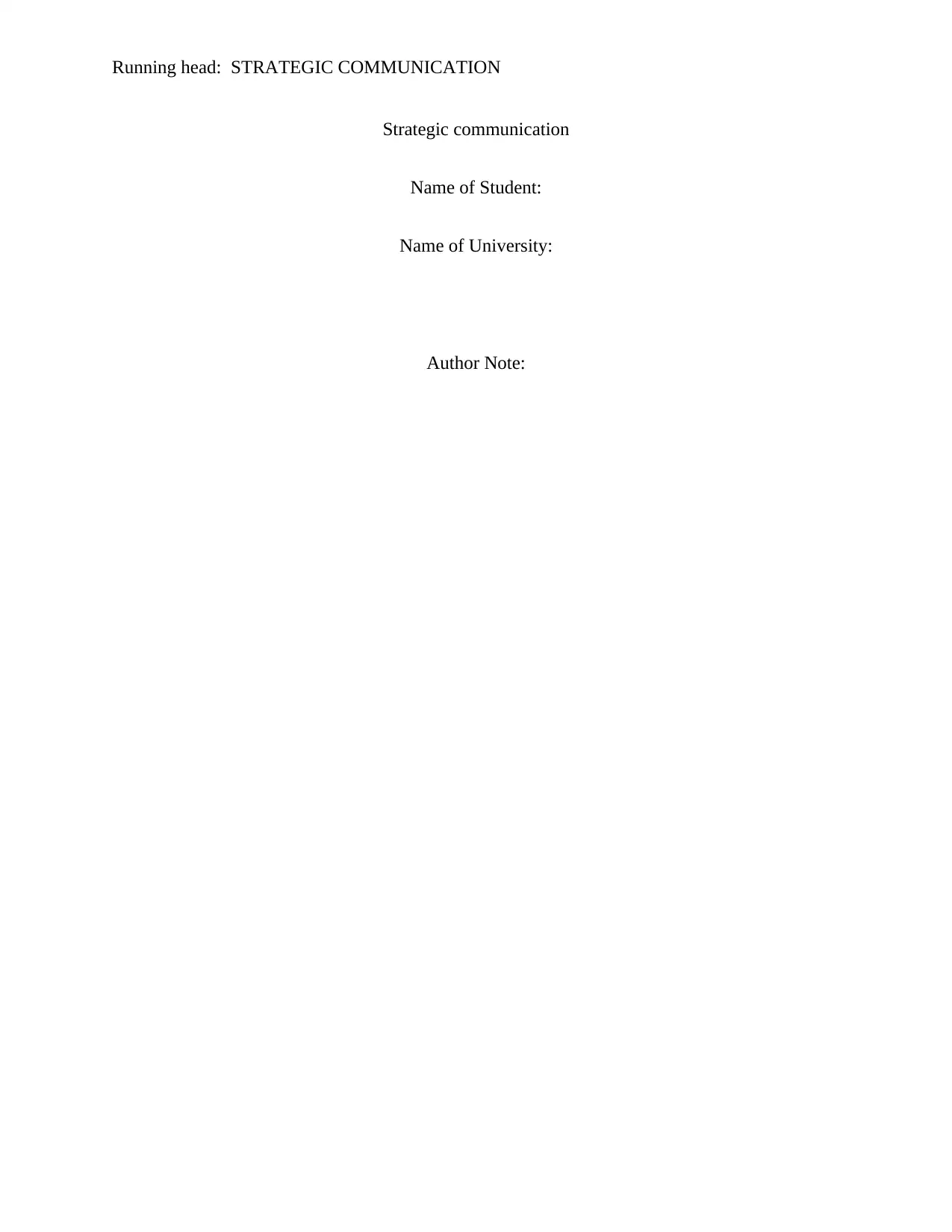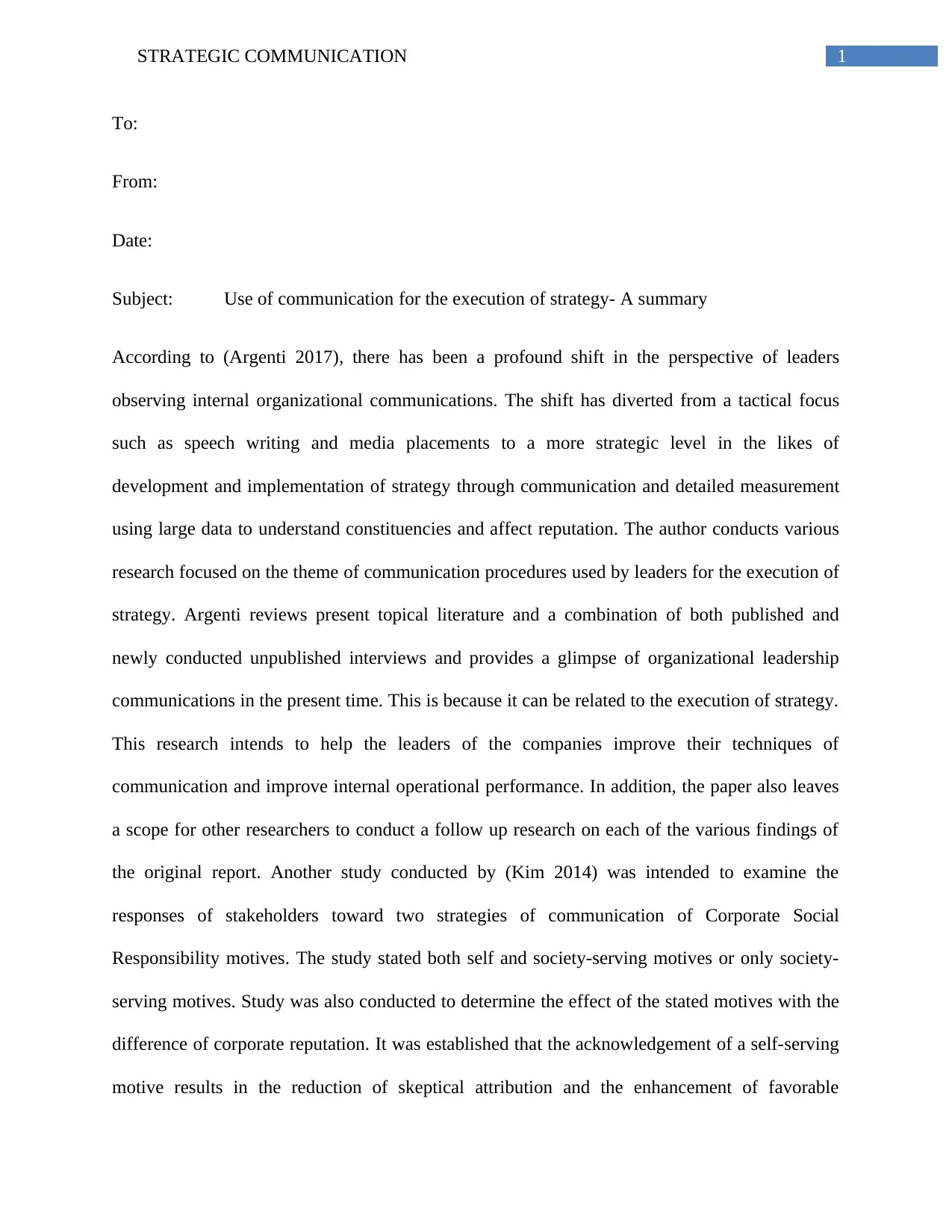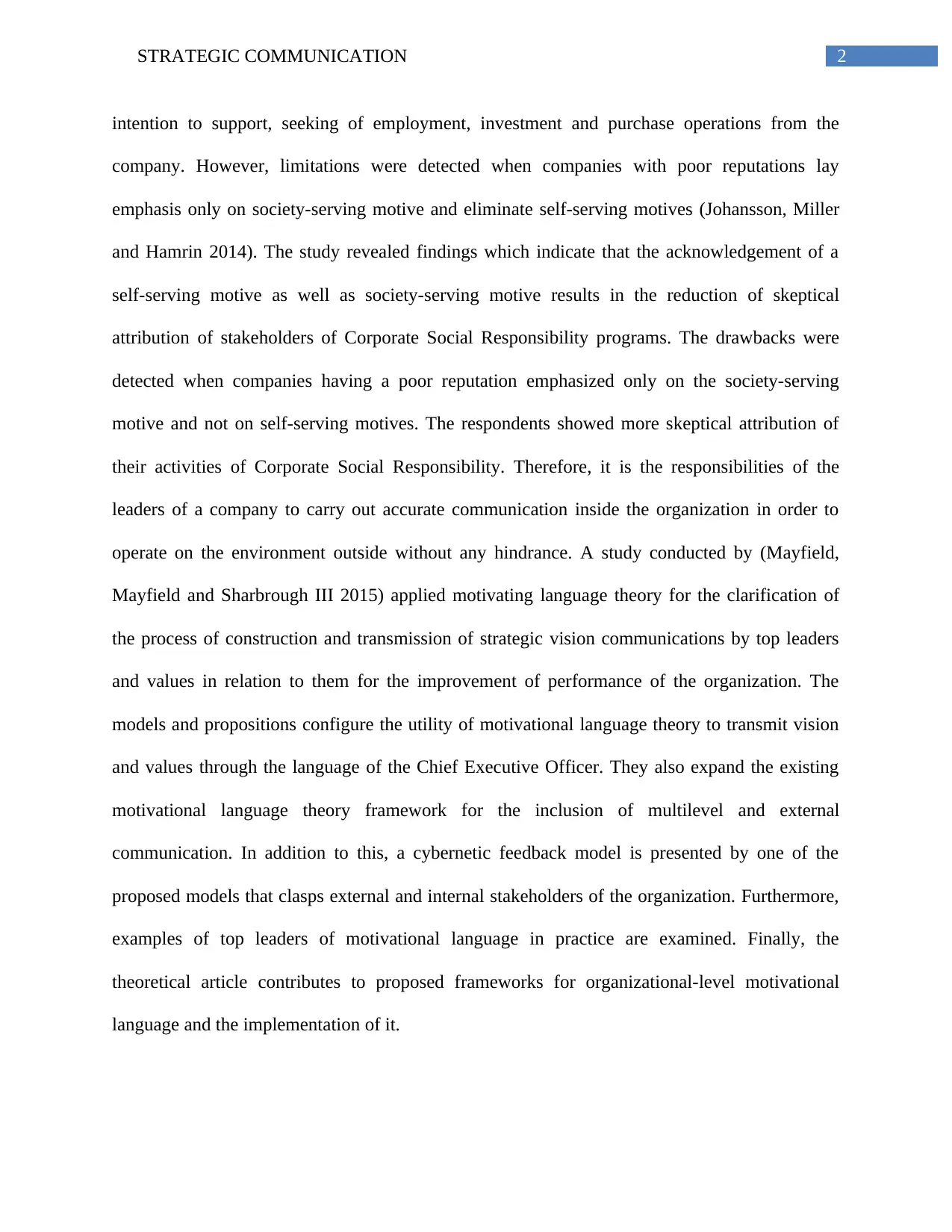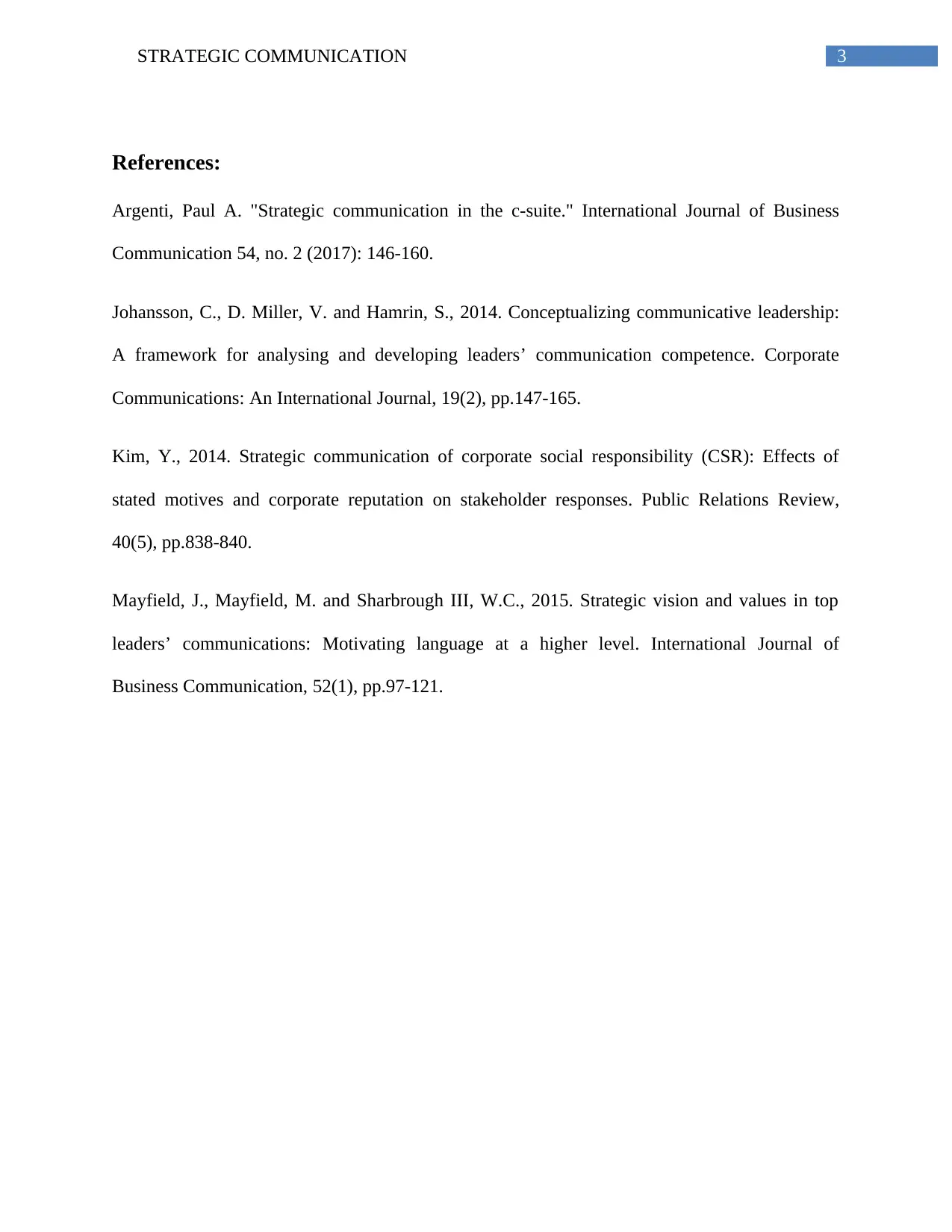Strategic Communication: How Leaders Use Communication for Strategy
VerifiedAdded on 2023/06/10
|4
|762
|258
Literature Review
AI Summary
This literature review summarizes research on strategic communication and its role in strategy execution. It highlights Argenti's work on the shift towards strategic internal communication, Kim's study on stakeholder responses to CSR communication strategies (emphasizing the importance of acknowledging self-serving motives alongside society-serving ones, especially for companies with poor reputations), and Mayfield et al.'s application of motivating language theory for transmitting strategic vision and values. The review synthesizes these findings to underscore the critical role of effective communication, both internally and externally, in achieving organizational goals and fostering positive stakeholder relationships. Desklib provides access to similar solved assignments.

Running head: STRATEGIC COMMUNICATION
Strategic communication
Name of Student:
Name of University:
Author Note:
Strategic communication
Name of Student:
Name of University:
Author Note:
Paraphrase This Document
Need a fresh take? Get an instant paraphrase of this document with our AI Paraphraser

1STRATEGIC COMMUNICATION
To:
From:
Date:
Subject: Use of communication for the execution of strategy- A summary
According to (Argenti 2017), there has been a profound shift in the perspective of leaders
observing internal organizational communications. The shift has diverted from a tactical focus
such as speech writing and media placements to a more strategic level in the likes of
development and implementation of strategy through communication and detailed measurement
using large data to understand constituencies and affect reputation. The author conducts various
research focused on the theme of communication procedures used by leaders for the execution of
strategy. Argenti reviews present topical literature and a combination of both published and
newly conducted unpublished interviews and provides a glimpse of organizational leadership
communications in the present time. This is because it can be related to the execution of strategy.
This research intends to help the leaders of the companies improve their techniques of
communication and improve internal operational performance. In addition, the paper also leaves
a scope for other researchers to conduct a follow up research on each of the various findings of
the original report. Another study conducted by (Kim 2014) was intended to examine the
responses of stakeholders toward two strategies of communication of Corporate Social
Responsibility motives. The study stated both self and society-serving motives or only society-
serving motives. Study was also conducted to determine the effect of the stated motives with the
difference of corporate reputation. It was established that the acknowledgement of a self-serving
motive results in the reduction of skeptical attribution and the enhancement of favorable
To:
From:
Date:
Subject: Use of communication for the execution of strategy- A summary
According to (Argenti 2017), there has been a profound shift in the perspective of leaders
observing internal organizational communications. The shift has diverted from a tactical focus
such as speech writing and media placements to a more strategic level in the likes of
development and implementation of strategy through communication and detailed measurement
using large data to understand constituencies and affect reputation. The author conducts various
research focused on the theme of communication procedures used by leaders for the execution of
strategy. Argenti reviews present topical literature and a combination of both published and
newly conducted unpublished interviews and provides a glimpse of organizational leadership
communications in the present time. This is because it can be related to the execution of strategy.
This research intends to help the leaders of the companies improve their techniques of
communication and improve internal operational performance. In addition, the paper also leaves
a scope for other researchers to conduct a follow up research on each of the various findings of
the original report. Another study conducted by (Kim 2014) was intended to examine the
responses of stakeholders toward two strategies of communication of Corporate Social
Responsibility motives. The study stated both self and society-serving motives or only society-
serving motives. Study was also conducted to determine the effect of the stated motives with the
difference of corporate reputation. It was established that the acknowledgement of a self-serving
motive results in the reduction of skeptical attribution and the enhancement of favorable

2STRATEGIC COMMUNICATION
intention to support, seeking of employment, investment and purchase operations from the
company. However, limitations were detected when companies with poor reputations lay
emphasis only on society-serving motive and eliminate self-serving motives (Johansson, Miller
and Hamrin 2014). The study revealed findings which indicate that the acknowledgement of a
self-serving motive as well as society-serving motive results in the reduction of skeptical
attribution of stakeholders of Corporate Social Responsibility programs. The drawbacks were
detected when companies having a poor reputation emphasized only on the society-serving
motive and not on self-serving motives. The respondents showed more skeptical attribution of
their activities of Corporate Social Responsibility. Therefore, it is the responsibilities of the
leaders of a company to carry out accurate communication inside the organization in order to
operate on the environment outside without any hindrance. A study conducted by (Mayfield,
Mayfield and Sharbrough III 2015) applied motivating language theory for the clarification of
the process of construction and transmission of strategic vision communications by top leaders
and values in relation to them for the improvement of performance of the organization. The
models and propositions configure the utility of motivational language theory to transmit vision
and values through the language of the Chief Executive Officer. They also expand the existing
motivational language theory framework for the inclusion of multilevel and external
communication. In addition to this, a cybernetic feedback model is presented by one of the
proposed models that clasps external and internal stakeholders of the organization. Furthermore,
examples of top leaders of motivational language in practice are examined. Finally, the
theoretical article contributes to proposed frameworks for organizational-level motivational
language and the implementation of it.
intention to support, seeking of employment, investment and purchase operations from the
company. However, limitations were detected when companies with poor reputations lay
emphasis only on society-serving motive and eliminate self-serving motives (Johansson, Miller
and Hamrin 2014). The study revealed findings which indicate that the acknowledgement of a
self-serving motive as well as society-serving motive results in the reduction of skeptical
attribution of stakeholders of Corporate Social Responsibility programs. The drawbacks were
detected when companies having a poor reputation emphasized only on the society-serving
motive and not on self-serving motives. The respondents showed more skeptical attribution of
their activities of Corporate Social Responsibility. Therefore, it is the responsibilities of the
leaders of a company to carry out accurate communication inside the organization in order to
operate on the environment outside without any hindrance. A study conducted by (Mayfield,
Mayfield and Sharbrough III 2015) applied motivating language theory for the clarification of
the process of construction and transmission of strategic vision communications by top leaders
and values in relation to them for the improvement of performance of the organization. The
models and propositions configure the utility of motivational language theory to transmit vision
and values through the language of the Chief Executive Officer. They also expand the existing
motivational language theory framework for the inclusion of multilevel and external
communication. In addition to this, a cybernetic feedback model is presented by one of the
proposed models that clasps external and internal stakeholders of the organization. Furthermore,
examples of top leaders of motivational language in practice are examined. Finally, the
theoretical article contributes to proposed frameworks for organizational-level motivational
language and the implementation of it.
⊘ This is a preview!⊘
Do you want full access?
Subscribe today to unlock all pages.

Trusted by 1+ million students worldwide

3STRATEGIC COMMUNICATION
References:
Argenti, Paul A. "Strategic communication in the c-suite." International Journal of Business
Communication 54, no. 2 (2017): 146-160.
Johansson, C., D. Miller, V. and Hamrin, S., 2014. Conceptualizing communicative leadership:
A framework for analysing and developing leaders’ communication competence. Corporate
Communications: An International Journal, 19(2), pp.147-165.
Kim, Y., 2014. Strategic communication of corporate social responsibility (CSR): Effects of
stated motives and corporate reputation on stakeholder responses. Public Relations Review,
40(5), pp.838-840.
Mayfield, J., Mayfield, M. and Sharbrough III, W.C., 2015. Strategic vision and values in top
leaders’ communications: Motivating language at a higher level. International Journal of
Business Communication, 52(1), pp.97-121.
References:
Argenti, Paul A. "Strategic communication in the c-suite." International Journal of Business
Communication 54, no. 2 (2017): 146-160.
Johansson, C., D. Miller, V. and Hamrin, S., 2014. Conceptualizing communicative leadership:
A framework for analysing and developing leaders’ communication competence. Corporate
Communications: An International Journal, 19(2), pp.147-165.
Kim, Y., 2014. Strategic communication of corporate social responsibility (CSR): Effects of
stated motives and corporate reputation on stakeholder responses. Public Relations Review,
40(5), pp.838-840.
Mayfield, J., Mayfield, M. and Sharbrough III, W.C., 2015. Strategic vision and values in top
leaders’ communications: Motivating language at a higher level. International Journal of
Business Communication, 52(1), pp.97-121.
1 out of 4
Your All-in-One AI-Powered Toolkit for Academic Success.
+13062052269
info@desklib.com
Available 24*7 on WhatsApp / Email
![[object Object]](/_next/static/media/star-bottom.7253800d.svg)
Unlock your academic potential
Copyright © 2020–2025 A2Z Services. All Rights Reserved. Developed and managed by ZUCOL.
